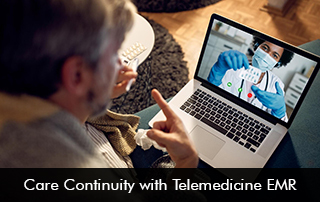Care continuity is crucial to boosting health outcomes. Electronic Medical Records (EMR) Software integrated with Telemedicine EMR Software can empower providers to offer efficient and uninterrupted virtual care. Via telehealth software, clinicians can provide services for consultations, patient education, and monitoring of various chronic conditions.
What is Care Continuity?
Care continuity means that patients get smooth and well-organized healthcare throughout their journey, no matter which doctors, hospitals, or time frames are involved. It makes sure that a patient’s medical background, treatments, and care plans are up-to-date and shared between healthcare providers, so nothing gets missed. This results in better health for patients, fewer mistakes, and a more satisfying experience for everyone involved.
How can Telemedicine EMR Software Support Care Continuity?
Telemedicine EMR Software is a robust virtual care tool that came to the forefront of care during the doom of the COVID-19 pandemic. According to the American Telehealth Association ATA 2023, patients with chronic conditions are most likely to make use of the telemedicine platform.
Care continuity with Telemedicine EHR Software can enhance coordination between specialists, reduce chances of medical errors, and open avenues to improve healthcare delivery.
Remote Access to Patient Records
The Telemedicine EMR Software allows healthcare providers to easily get to a patient’s full and most current medical records no matter where they are. This is incredibly helpful for managing ongoing health issues and checking in on patients after they’ve left the hospital, as it gives doctors all the information they need to keep treating patients effectively.
Smooth Data Exchange
Interoperability options in Telemedicine EHR Software can support seamless data exchange and care coordination between various medical specialists. This is critical in offering holistic and personalized care, while also bridging any gaps in care.
Virtual Consultations and Follow-Ups
Patients have the option to connect with their healthcare providers from afar, which means fewer office visits while still keeping a close eye on and managing their health. With Telemedicine EMR Software, doctors can consult via video calls, exchange messages, and even write electronic prescriptions, so quality care can continue seamlessly, no matter the distance.
How to Implement Telemedicine EHR Software Successfully?
- A stable and fast internet is required for seamless telehealth consultations to proceed. A smooth internet connection can ensure clear video and audio during online sessions.
- To maintain patient privacy the telemedicine software system should comply with HIPAA laws.
- An intuitive interface will encourage more patients to book online consultations and keep them satisfied.
Moving Ahead
Practices that want to stay ahead have implemented Telemedicine Electronic Medical Records Software. Virtual sessions can transform care, increase access, and even reduce healthcare costs. It is a win-win situation to use Telemedicine EMR Software in today’s demanding environment.








